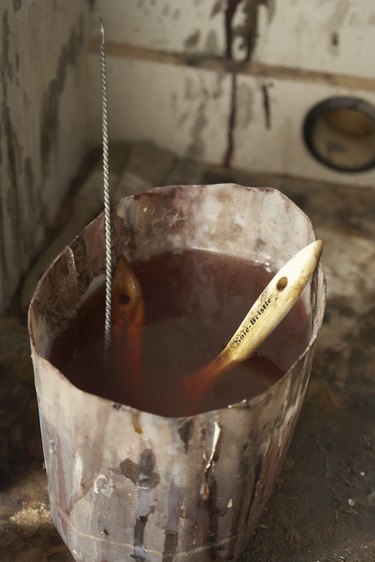
Painters in the early 20th century and before had few choices for solvents for thinning paint or varnish, or for cleaning up after painting. Most used turpentine, a solvent distilled from the sap of the pine tree. Today, painters use mineral spirits when they need a relatively mild, slow-drying solvent. When professional painters are spraying paint and need a more volatile solvent with greater ability to dissolve solids, most rely on lacquer thinner.
Mineral Spirits
Video of the Day
Before the second World War, all brushable paints were oil-based, and mineral spirits were used to thin them. Distilled from petroleum, mineral spirits are no longer considered equivalent to other paint thinners now that water-soluble latex paint products are on the market. But mineral spirits are still the best thinner for alkyd paints and most varnishes. Their relatively slow evaporation rate, when compared with naptha, another type of paint thinner, is desirable because it gives oil-based paints time to level out before they dry. This prevents cracking, checking and other defects.
Video of the Day
Lacquer Thinner
The solvent you find on the shelves with a label identifying it as lacquer thinner is a combination of a variety of volatile chemicals, including acetone, toluene, xylene and methyl ethyl ketone. Not all lacquer thinners contain the same combination of chemicals, but they are all capable of dissolving lacquer and shellac, as well as a variety of plastics and hardened paints. Lacquer thinner is highly volatile compared with mineral spirits and is the only thinner you can use for spraying lacquer. It quickly evaporates after the lacquer settles, which then flash-dries in a matter of minutes.
Uses
Both mineral spirits and lacquer thinner are derived from petroleum, but mineral spirits retain more of the oily nature of petroleum that gives it lubricating properties. You can use mineral spirits to lubricate sharpening stones and to thin oil and wax, as well as to clean either of these substances from tools and surfaces. Lacquer thinner has no such properties, but it has more ability to cut through grease and wax than mineral spirits. You can also use lacquer thinner to remove many types of dried paint from metal or wood. Unlike mineral spirits, lacquer thinner quickly evaporates and leaves no oily residue behind.
Considerations
Both mineral spirits and lacquer thinner are highly flammable, and you should use neither solvent near open flame or a source of high heat. Neither smells pleasant, but the high volatility of lacquer thinner, together with the fact that many of the chemicals in it are neurotoxins, means that you should never use it for a prolonged period without the protection of a respirator. Mineral spirits, while not as effective as a grease-cutter as lacquer thinner, is safer to use. Not only does it present less of a breathing hazard, it is less likely to damage the surface you are cleaning.